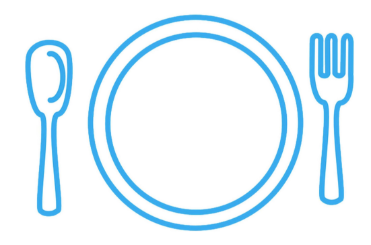A simple guide to our blog: how to glean essential info from Savvy Grub.
Our recipes are inherently wheat and gluten free, peanut free, mostly nightshade free, corn and soy free, largely diary and lactose free, mostly vegetarian, easily made vegan, and several are grain-free and paleo!
FIRST STOP: what is SAVVYGRUB all about??
Dana is a Registered Dietitian Nutritionist and Personal Trainer. Josh is a former CPA, CFO. Together we create budget-friendly nourishing solutions to otherwise expensive good food. Dig deep into the top menu bar tab “A SOLUTION“. There you will find a plethora of detailed WHAT, HOW & WHY:
Very seriously, read or at least skim through those. We already did the ground work for you!
If you skip those pages, you likely won’t understand our mission, how we fixed our budget, or where to begin.
NEXT STOPS:
READ this quick guide and you’ll maximize your budget savings and mealtime nourishment on-the-fly.

For many people, creating an “A” meal from a single recipe is ideal because there is less work required.
That said, there are occasions when we need the liberty of going gourmet but don’t want to break the bread-budget doing it: hosting for a gourmet dinner party, mixing up the menu for a special occasion, just because I want yummy fancy food…
< your reason here >
That’s why I created a separate section in the majority of the recipe posts you’ll find on our site. It’s called: Savvy Alternates. Hello food budget buddy.
Here’s an example from our Tangy Beet Salad recipe post:

How to Calculate YOUR “monthly cost”:
It is critical to note that the each of our recipe’s “monthly cost” is calculated based on two people, eating cumulatively 4,000 Calories per day, if they only ate that one meal all-month-long. If you’re flying solo and eating 2,000 Calories per day — then divide this number in half. If you need less than or more than 2,000 Calories per day, then simply fraction out your total like this:
Example:
Someone eating the original Tangy Beet Salad recipe (line 1 in the “Savvy Alternates” table above) — all-month-long –to fulfill a daily need of 1,500 Calories per day, would generate a monthly cost (monthly grocery bill) of:
1,500 kcal / 4,000 kcal = $x / $767 … $287.63 per month
We certainly do not recommend only eating a single recipe all-month-long. That would likely result in nutrient deficiencies and related negative consequences.
We spell out the monthly calculation in this manner to create a clear measuring stick for how much a meal will impact a monthly grocery bill.
Onward
In addition to the tips & tricks, substitutes listed, and alternate ideas proposed in the table, you’ll also find a bunch of $ -saving savvy tips to help you get the most nourishment out of your food bill and hopefully increase savings along the way!
Look for this:
$ – SAVVY: key information you need to know to beat the grocery bill and bank on saving $, time, and upping nourishment.
Just in case you miss it:
Here are a few cost-cutting and nourishment tips I wove into a few posts. If you don’t see those ones, here’s the short:
Inorganic or Organic. The Clean-15 and Dirty-Dozen.
Let’s talk briefly about cost. We try to buy organic produce where possible and when the budget permits. The easy “inorganic” buys are listed on the EWG’s “clean-15” list. The trickier produce to navigate are those not listed on the dirty dozen. One example: Sweet potatoes are technically not listed on the 2019 dirty dozen. Sometimes costs are the same!

As you can see, “potatoes” are listed in the 2019 dirty dozen, but not “sweet potatoes”. A quick Google search of the “clean 15″ list from 2015 will show you our favorite – the sweet potato – is included as a clean veggie. In 2015 I would more readily buy inorganic sweet potatoes than in 2019.
That said, it seems to be a mixed bag, from a pesticide perspective, of whether or not to only buy these organic in 2019. If you’re feeding littles, I recommend buying organic. The best deal we’ve found is a 3, 6, or 10 lb bag at Costco for about $1.30 to $1.60 per pound (when they carry them). Otherwise, try to shop local sales.
The Savvy Solution to an Expensive Recipe
- Change the original recipe so that it has more calories with less expensive food.
- Sometimes changing the original means using less expensive food with fewer calories.
- Add a low cost side dish with a lot of calories to bring your total cost per Calorie down.
- Use a combination of both: add a higher calorie, low cost side AND alter the main dish so it fits your budget.
- In the case of the “Savory Bell Peppers” – this option created the A-priced meal.
Each variation requires a shift towards creative-thinking while evaluating your objectives and balancing your guests’ preference with your own food budget.
It’s worth reading through various recipe posts and not just skipping to the recipe. I (Dana) really think about every sentence I write and just plain don’t have time for fluff and stuff.
You’ll find these posts are refreshingly shorter than the abundance of (annoyingly) long food posts with excess jargon. You just won’t find that gobbledygook here!
#aintnobodygottimeforthat
We’re here to help SAVE US ALL SOME MONEY AND TIME!!
More to come. This guide will grow as our content grows. We welcome your creativity, insight, time or money saving tips and thoughtful feedback!

